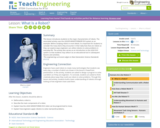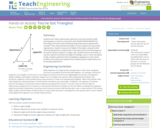
Allows students to submit a request for a telescope in England to view a portion of the sky. The telescope is robotically controlled via the internet.
- Subject:
- Science
- Material Type:
- Interactive
- Date Added:
- 12/01/2023

Allows students to submit a request for a telescope in England to view a portion of the sky. The telescope is robotically controlled via the internet.

This lesson introduces students to the major characteristics of robots. The associated activity uses the LEGO MINDSTORMS(TM) NXT system as an example. Before studying robots in more detail, it is important for students to consider the many items they encounter in their daily lives that are robots so they can explore ways engineers can utilize robotics to solve problems in everyday life.The activity also serves as an introduction to the LEGO NXT system so that students may utilize it as an educational tool in subsequent lessons and activities.

In this part of our series, computer scientist Casey Stone and Division Director for the Center for Nanoscale Materials Ilke Arslan provide an inside look into autonomous discovery. Autonomous discovery is a process that harnesses the power of robotics, artificial intelligence and machine learning to bring scientific breakthroughs to the world faster than ever before

Students learn about trigonometry, geometry and measurements while participating in a hands-on interaction with LEGO® MINDSTORMS® NXT technology. First they review fundamental geometrical and trigonometric concepts. Then, they estimate the height of various objects by using simple trigonometry. Students measure the height of the objects using the LEGO robot kit, giving them an opportunity to see how sensors and technology can be used to measure things on a larger scale. Students discover that they can use this method to estimate the height of buildings, trees or other tall objects. Finally, students synthesize their knowledge by applying it to solve similar problems. By activity end, students have a better grasp of trigonometry and its everyday applications.